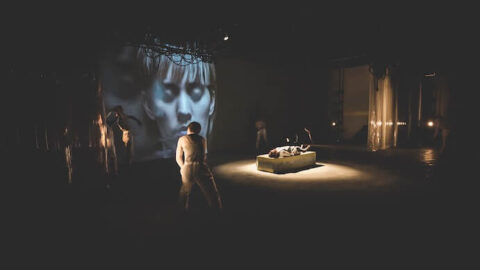Simulacrum—PATH New Music Theater’s debut project performed on June 8-10th at the 3-Legged Dog (3LD) Art & Technology Center in downtown Manhattan–is an ambitious, 50-minute contemporary opera. It tells the story of Lydia (sung by Lucy Dhegrae), a dancer who has lost her leg (a character in and of itself, “Stump,” played by Nina Dante) as she attempts to connect with a new Bionic Leg (sung by Nathaniel Sullivan). Lydia’s partner Elias (also portrayed by Sullivan) grapples with the loss of her old body and the adjustment to her new body, too. More broadly, Simulacrum attempts to explore the challenge of “find[ing] the line between humanity and technology.”
The story of Lydia’s transformation, and her relationships with Elias, her old leg, and her new leg, is abstract in and of itself—it takes some adjusting to see a human person singing the role of a bionic leg. Yet storytelling in Simulacrum is further abstracted by the combination of (deliberately) stuttered and scattered lyrics and lack of a printed libretto, diverging from the tradition of projection supertitles or providing the text in the program. While distinct plot and clear text-delivery take a backseat in this production, Simulacrum focuses on using the myriad of artistic tools accrued by PATH and 3LD.
More than contemporary opera, the most fitting depiction of Simulacrum comes from its program notes: a scenario of “live singers and dancers inside a whirling technological landscape of projections and new music.” Simulacrum is the product of a multitude of collaborators: six composers, a librettist, a director, a choreographer, a team of designers, and performers (three main singers, dancers, and a group of musicians). Throw on top of that a slew of various technologies (prerecorded video projections, live video projections, audio distortions, costumes with neck and leg pieces that light up) and you can begin to picture just how much Simulacrum packs into a little under an hour.
The music–composed by PATH’s composers James Diaz, Peter Kramer, Longfei Li, Yangzhi Ma, and Meng Wang, along with guest composer Reiko Füting–sets a rather ominous tone: Technology, should we be scared? Despite the fact that Simulacrum is five scenes, a prologue, and an epilogue written in distinct parts by these six different composers, the sound world is similar from one section to the next. The tendency to hover around single pitches or small pitch clusters permeates the entire work, as do the various rhythmic and timbral techniques used to create variety and texture within this harmonic paradigm. The resulting mood is one of mystery, creating a world that is sometimes sinister and other times introspective and hopeful. To many listeners, it could seem that the opera was written by a single composer; to more locally-trained ears, the similarities ring with the influence of composer and professor Reiko Füting.

The singers tackled the daunting task of fitting into a prerecorded instrumental and vocal soundtrack, often blending seamlessly with the recorded audio and leaving the audience unclear as to what music was happening live and what music was prerecorded. Lucy Dhegrae was particularly memorable as Lydia, showing wonderful restraint to blend and sometimes hide behind the complicated and thick timbral texture of other voices and instruments that then allowed her most emotional and human moments to pierce through the chaotic texture.
There were moments in Simulacrum where incorporating technologies into the opera worked wonderfully in the performance. The costume designs combined with the choreography were particularly imaginative, starting with dancers wearing white wind pants that whistled as they walked, creating a crescendo of sound as the walking turned to running. The costumes also were able to visually convey the theme of integrating technology and humanity: Lydia’s bionic leg was dressed in skeletal lights, and dancers in the final scene wore light sculptures around their necks in a display of collaboration between the two previously opposing forces.

Yet there were elements of Simulacrum where various media did not work as well together. Sometimes it felt as if things were happening simply to take advantage of another collaborator or resource on hand rather than imbuing the opera with further meaning. While the climactic moment of Lydia embracing her bionic leg was made particularly powerful by the use of singers, dancers, and technology coming together, there were many moments earlier in the production where these elements performed simultaneously seemed distracted and unrelated to each other.
In the program notes for Simulacrum, PATH provides a long list of questions for listeners to contemplate over the course of the opera: “What do we lose when we weld ourselves to our technology? What do we gain? What does this mean for our sense of reality?” Yet such leading questions should be, and often were, unnecessary: left to its own devices, Simulacrum addresses the anxieties created by an increasingly technological world, and the subsequent humanity of such anxiety.
























